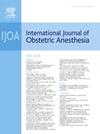低剂量脊髓硬膜外联合剖宫产治疗先天性中枢性低通气综合征1例。
IF 2.3
3区 医学
Q2 ANESTHESIOLOGY
引用次数: 0
摘要
先天性中枢性低通气综合征(CCHS),也被称为Ondine的诅咒,是一种自主神经障碍,导致呼吸系统对高碳酸血症和低氧反应不足,特别是在清醒度下降期间。CCHS患者对麻醉药物的影响特别敏感,术中发生低血压、心动过缓和低氧血症等事件的风险增加。目前关于CCHS患者麻醉管理的文献主要描述了全麻的使用,很少有关于神经轴向麻醉的病例报道。据我们所知,这是第一例描述低剂量脊髓硬膜外联合麻醉对CCHS患者剖宫产的麻醉护理。患者既往有两次剖宫产伴脊髓麻醉,并发低血压和晕厥继发于自主神经功能障碍和/或神经介导性晕厥。本病例强调了低剂量脊髓硬膜外联合麻醉作为CCHS患者可能的麻醉方法,可降低低血压和呼吸抑制的风险。本文章由计算机程序翻译,如有差异,请以英文原文为准。
Cesarean delivery with low-dose combined spinal epidural in a patient with congenital central hypoventilation syndrome: a case report
Congenital central hypoventilation syndrome (CCHS), also known as Ondine’s Curse, is an autonomic disorder resulting in an inadequate respiratory response to hypercapnia and hypoxia, especially during periods of decreased wakefulness. Patients with CCHS are particularly sensitive to the effects of anesthetic medications, with increased risk for intraoperative events including hypotension, bradycardia, and hypoxemia. The current literature on the anesthetic management for patients with CCHS mainly described the use of general anesthesia, with few case reports describing neuraxial anesthesia. To our knowledge, this is the first case describing the anesthetic care for cesarean delivery of a patient with CCHS, with low-dose combined spinal epidural anesthesia. The patient had two previous cesarean deliveries with spinal anesthesia, complicated by hypotension and syncope secondary to autonomic dysfunction and/or neural-mediated syncope. This case highlights low-dose combined spinal epidural as a possible anesthetic approach in patients with CCHS, reducing the risk of hypotension and respiratory depression.
求助全文
通过发布文献求助,成功后即可免费获取论文全文。
去求助
来源期刊
CiteScore
4.70
自引率
7.10%
发文量
285
审稿时长
58 days
期刊介绍:
The International Journal of Obstetric Anesthesia is the only journal publishing original articles devoted exclusively to obstetric anesthesia and bringing together all three of its principal components; anesthesia care for operative delivery and the perioperative period, pain relief in labour and care of the critically ill obstetric patient.
• Original research (both clinical and laboratory), short reports and case reports will be considered.
• The journal also publishes invited review articles and debates on topical and controversial subjects in the area of obstetric anesthesia.
• Articles on related topics such as perinatal physiology and pharmacology and all subjects of importance to obstetric anaesthetists/anesthesiologists are also welcome.
The journal is peer-reviewed by international experts. Scholarship is stressed to include the focus on discovery, application of knowledge across fields, and informing the medical community. Through the peer-review process, we hope to attest to the quality of scholarships and guide the Journal to extend and transform knowledge in this important and expanding area.

 求助内容:
求助内容: 应助结果提醒方式:
应助结果提醒方式:


